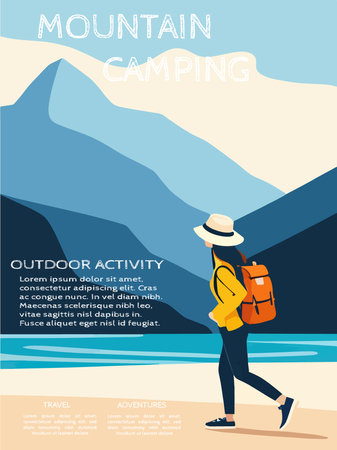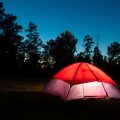Understanding Your Cooling Needs
If youre getting ready for your first camping trip in the U.S., picking the right cooler might feel a bit overwhelming. But don’t worry! The key is to figure out what you actually need to keep cold. Here’s how you can break it down:
Trip Length Matters
The length of your camping adventure makes a big difference. Are you heading out just for the weekend or planning a whole week in the great outdoors? The longer your trip, the more space and ice retention youll need from your cooler.
| Trip Length | Recommended Cooler Size | Ice Retention Needed |
|---|---|---|
| 1-2 days | Small (20-30 quarts) | 24-48 hours |
| 3-4 days | Medium (40-50 quarts) | 3-4 days |
| 5+ days | Large (60+ quarts) | 5+ days |
Group Size and Cooler Capacity
Bigger groups mean more food and drinks to chill. Are you camping solo, with family, or with a bunch of friends? Here’s a quick reference:
| Group Size | Suggested Cooler Capacity |
|---|---|
| 1-2 people | 20-30 quarts |
| 3-4 people | 40-50 quarts |
| 5+ people | 60+ quarts or multiple coolers |
The Types of Food and Drinks You’ll Bring Along
Your menu plays a huge role too. If you’re packing mostly drinks and snacks, a smaller cooler works. But if you’re bringing raw meat, dairy, or fresh produce for full meals, you’ll want something bigger—and maybe even two separate coolers: one for drinks, one for food.
Sample Packing List Breakdown:
| Campsite Menu Style | Cooled Items Example | Cooler Needs |
|---|---|---|
| Beverages & Snacks Only | Soda, water bottles, fruit, cheese sticks | Small cooler, less ice needed |
| Full Meals (Breakfast/Lunch/Dinner) | Bacon, eggs, steak, veggies, milk, condiments | Larger cooler(s), strong ice retention |
Quick Tips:
- If you plan to fish or hunt while camping, factor in extra space for your catch.
- Avoid over-packing—leave room for ice packs!
- If it’s hot out or you’re far from civilization, always opt for a cooler with better insulation.
By thinking about these factors—how long youll be gone, how many folks are coming along, and what types of eats and drinks you want to bring—youll be ready to pick out the perfect cooler for your first camping trip!
2. Types of Coolers: Pros and Cons
When you’re planning your first camping trip, picking the right cooler can make a big difference in how much you enjoy your adventure. There are several types of coolers to choose from, each with their own unique perks and drawbacks. Let’s break down the main styles—hard-sided, soft-sided, backpack, and electric coolers—so you can figure out what fits your needs best.
Hard-Sided Coolers
These are the classic coolers most people think of when they picture a camping trip. Hard-sided coolers are sturdy and usually offer the best insulation.
| Pros | Cons |
|---|---|
| Excellent ice retention Durable and tough Can double as an extra seat or table |
Heavier and bulkier Takes up more space in your car Not as easy to carry long distances |
Soft-Sided Coolers
If you’re looking for something lighter, soft-sided coolers might be right for you. These coolers are made from flexible materials like fabric or vinyl.
| Pros | Cons |
|---|---|
| Lighter weight Easier to store and carry Great for short trips or day hikes |
Less insulation than hard-sided Not as durable Can leak if not handled carefully |
Backpack Coolers
Backpack coolers combine the convenience of a backpack with the function of a cooler. They’re awesome for campers who need to walk a bit to get to their site.
| Pros | Cons |
|---|---|
| Hands-free carrying Perfect for hiking into remote campsites Usually lightweight and compact |
Limited storage space Doesn’t keep items cold as long as other types Not ideal for large groups or long trips |
Electric Coolers (Plug-In Coolers)
Electric coolers plug into your car’s 12V outlet or a portable power source. These work more like mini fridges on the go.
| Pros | Cons |
|---|---|
| No need for ice Constant cooling as long as power is available Great for road trips or RV camping |
Needs access to electricity or battery power Heavier than most soft-sided options Can be pricey compared to traditional coolers |
Quick Comparison Table
| Type of Cooler | Best For | Main Drawback |
|---|---|---|
| Hard-Sided Cooler | Longer trips, larger groups, rough conditions | Bigger and heavier to transport |
| Soft-Sided Cooler | Short outings, picnics, light packing needs | Poorer ice retention and durability |
| Backpack Cooler | Campsites that require hiking in, hands-free convenience | Lesser capacity and insulation time |
| Electric Cooler | Car camping, RVs, extended travel with power access | Needs electricity; higher cost |
Selecting the right cooler depends on your camping style, how far you have to carry your gear, and how long you’ll need to keep things chilled. Think about these factors before making your choice!

3. Key Features to Look For
When you’re picking out your first camping cooler, it’s easy to get overwhelmed by all the options out there. To help you make the right choice, here are the key features you should focus on. These essentials will keep your food fresh, your drinks cold, and your camping trip stress-free.
Insulation
The main job of a cooler is to keep things cold, so good insulation is a must. Look for coolers with thick walls and tight-fitting lids. Some premium models use extra foam or even special materials to keep ice frozen for days—perfect for longer trips or hot summer weekends.
Capacity
Coolers come in all shapes and sizes. Ask yourself how much space you really need. Are you packing meals just for yourself, or are you feeding a group? Here’s a quick guide to cooler sizes:
| Cooler Size | Best For | Capacity (Quarts) |
|---|---|---|
| Small | Day trips, solo campers | 10-20 |
| Medium | Weekend getaways, couples | 20-40 |
| Large | Family camping, group outings | 40-70+ |
Durability
Campsites can be tough on gear. Choose a cooler made from sturdy plastic or heavy-duty materials that can take a few knocks without cracking. Reinforced corners and strong handles make a big difference if you’re hauling it over rough ground or loading it in and out of your car.
Portability
You don’t want to struggle with a heavy cooler when you’re trying to set up camp. Look for features like built-in wheels, comfortable handles, or even backpack straps if you need to carry it farther from your car. Portability is especially important if you’ll be hiking to your campsite.
Weather Resistance
A good camping cooler should stand up to whatever Mother Nature throws at you—whether that’s rain, sun, or mud. Water-resistant seals, rust-proof hinges, and UV protection can help your cooler last longer and keep everything inside safe and dry.
Feature Comparison Table
| Feature | Why It Matters | What to Look For |
|---|---|---|
| Insulation | Keeps ice longer & preserves food/drinks | Thick walls, quality foam, tight seal lid |
| Capacity | Makes sure you have enough storage space | Sized for your group/trip length (see above) |
| Durability | Withstands outdoor use & travel bumps | Tough plastic, reinforced parts, strong latches/handles |
| Portability | Easier transport from car to campsite | Wheels, ergonomic handles, lightweight design |
| Weather Resistance | Keeps contents protected in any weather conditions | Waterproof seals, UV protection, rust-proof hardware |
By focusing on these key features while shopping for your first camping cooler, you’ll be well on your way to an awesome outdoor adventure with fresh food and cold drinks every step of the way.
4. Cooler Packing and Ice Retention Tips
Packing Your Cooler Like a Pro
Packing your cooler correctly can make all the difference on your first camping trip. Start by chilling everything before packing—put drinks and food in your fridge overnight so they’re already cold when you load up the cooler. Layering is key: place items you’ll need last at the bottom, and things you’ll want first (like snacks or drinks) on top. Try to pack your cooler as full as possible; less air inside means better ice retention.
Efficient Packing Checklist
| Item | Packing Order | Tip |
|---|---|---|
| Frozen meats & long-term foods | Bottom layer | Stay cold longest, less access needed |
| Dairy & prepared meals | Middle layer | Keep cool but easy to grab when needed |
| Snacks & drinks | Top layer | Quick access for convenience |
| Ice packs or blocks | Around sides & top | Create an “ice blanket” to maximize cooling |
Choosing the Best Ice Packs for Camping
You’ve got options when it comes to keeping your cooler chilly. Reusable ice packs are great because they don’t create a watery mess as they melt. For longer trips, consider using block ice—it melts slower than cubes or crushed ice. If you want something extra, try mixing both: use block ice at the bottom and fill gaps with smaller reusable packs or cubes. Just avoid loose ice if you’re worried about soggy food!
Popular Ice Options Compared
| Type of Ice/Ice Pack | Pros | Cons |
|---|---|---|
| Block Ice | Lasts longest, stays cold for days | Takes up more space, harder to fit around food/drinks |
| Cubed/Crushed Ice | Cools quickly, fills small spaces well | Melts fast, can get items wet if not sealed properly |
| Reusable Ice Packs | No mess, reusable, various sizes/shapes available | Might not stay cold as long as block ice alone on multi-day trips |
Maximizing Ice Retention for a Weekend Outdoors
If you want your cooler to stay frosty all weekend, keep it out of direct sunlight and only open it when absolutely necessary—every peek lets in warm air! Covering your cooler with a blanket or tarp can add extra insulation. Place a thermometer inside if you’re worried about temperature-sensitive foods. Remember, the fuller your cooler, the better it will hold its chill.
Quick Ice Retention Tips:
- Pre-chill your cooler with a bag of ice before packing (dump that ice right before loading).
- Avoid draining melted water unless it’s soaking into food—cold water helps keep things chilly.
- If possible, bring two coolers: one just for drinks (which gets opened often), and one for perishable food.
Your cooler can be the unsung hero of your camping adventure—pack smart, choose the right ice option, and enjoy fresh food throughout your weekend in nature!
5. Budget and Brand Recommendations
When it comes to choosing a cooler for your first camping trip, finding the right balance between price and quality is important. Whether you’re just starting out or have been camping for years, there are plenty of budget-friendly coolers and reliable American brands to consider. Here’s a quick guide to help you make an informed choice.
Budget-Friendly Cooler Options
You don’t need to spend a fortune to keep your food and drinks cold while camping. There are several affordable coolers that offer good insulation and durability. Look for models that fit your needs without extra bells and whistles if you’re just getting started.
| Brand | Model | Average Price Range | Best For |
|---|---|---|---|
| Coleman | Coleman 48-Quart Performance Cooler | $35-$50 | Weekend trips, family picnics |
| Igloo | Igloo MaxCold 50 QT Roller | $45-$70 | Easy transport, short camping trips |
| Rubbermaid | Rubbermaid DuraChill Wheeled 75QT Cooler | $55-$80 | Larger groups, car camping |
Trusted American Cooler Brands
If you want a cooler that will last for years or handle more rugged adventures, it’s worth investing in a trusted brand. Many American brands have built their reputations on quality and reliability. Here are some favorites among campers:
- YETI: Known for their tough construction and long ice retention, YETI coolers are popular with serious campers and outdoor enthusiasts. They tend to be pricier but are built to last.
- Pelican: Pelican coolers offer excellent insulation and sturdy designs perfect for longer trips or rough conditions.
- Engel: Engel coolers are another top choice, famous for their durability and ice-holding power.
- Coleman & Igloo: These classic American brands offer a range of coolers from budget-friendly to high-performance models, making them great options for both beginners and experienced campers.
Quick Comparison of Popular Brands
| Brand | Main Features | Price Range (USD) | User Level |
|---|---|---|---|
| Coleman | Affordable, easy to find, lightweight options available | $30-$100+ | Beginner to Intermediate |
| Igloo | Good value, variety of sizes, classic design choices | $40-$120+ | Beginner to Intermediate |
| YETI | Premium build, best ice retention, heavy-duty materials | $200-$400+ | Intermediate to Expert |
| Pelican/Engel | Tough construction, long-lasting performance, bear-resistant options available | $150-$350+ | Intermediate to Expert |
A Few Shopping Tips:
- If you camp only occasionally or on weekends, a mid-range cooler from Coleman or Igloo should cover your needs.
- If you plan on extended backcountry trips or need maximum ice retention, consider investing in a premium brand like YETI or Pelican.
- Check for seasonal sales at major retailers like Walmart, Target, REI, or online stores—sometimes you can score great deals!
Selecting the right cooler doesn’t have to be overwhelming. By considering your budget and checking out these trusted brands, you’ll be ready for any camping adventure—whether it’s your first trip or one of many!


